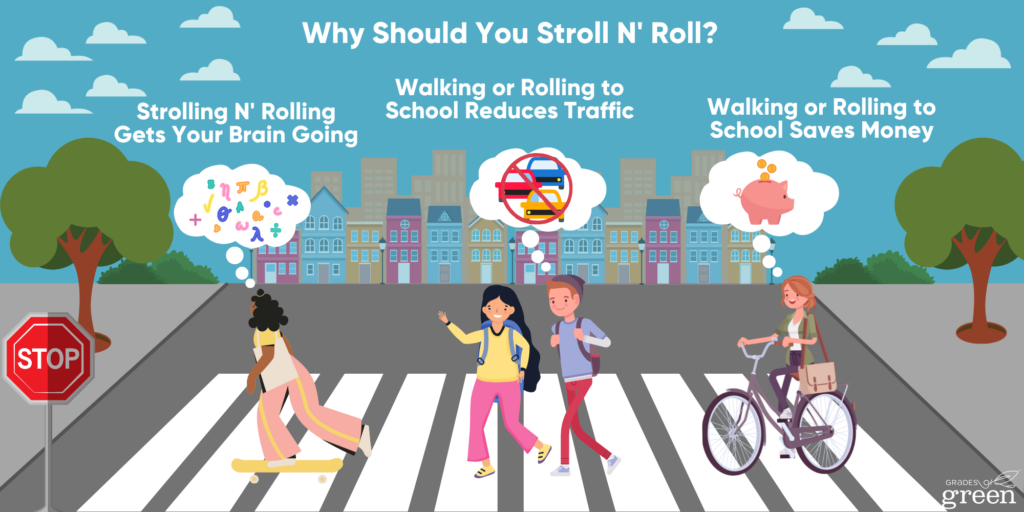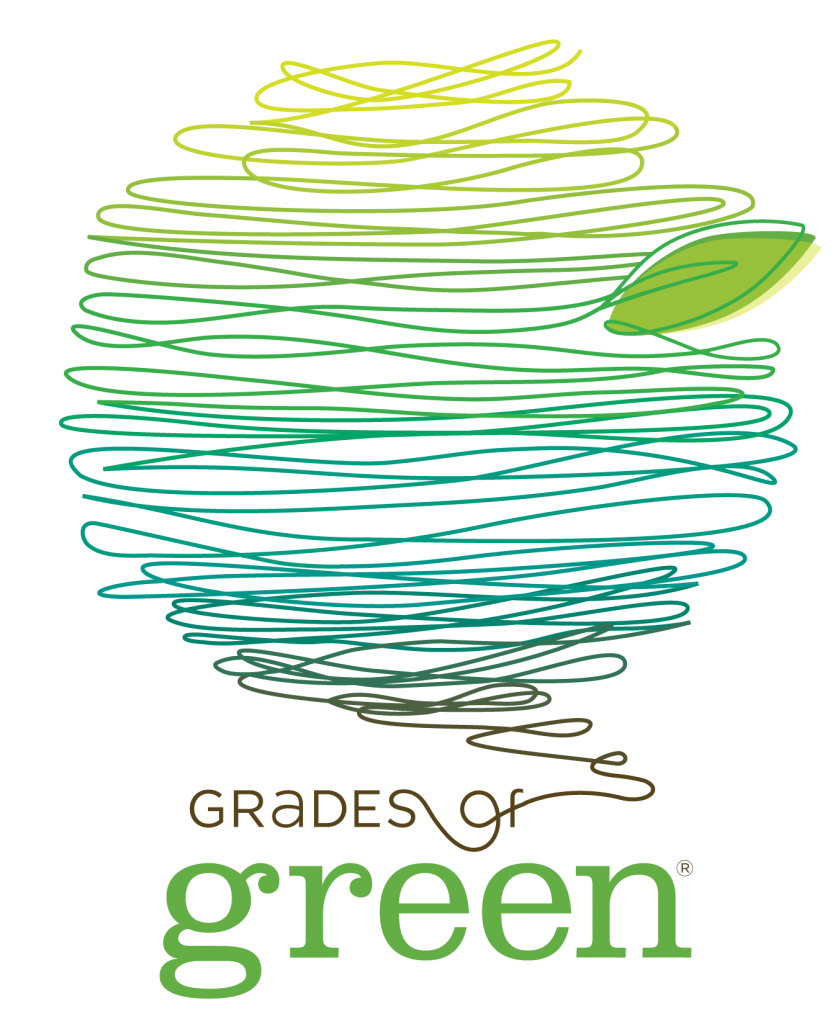Prevent carbon polluting our atmosphere by Strolling N’ Rolling to School!
With a majority of vehicles using gasoline to fuel cars, greenhouse gas emissions have grown immensely over the years. Students can take action to reduce these impacts by walking or biking to school. Get your shoes ready!

Toolkit Details


NGSS
This toolkit address the following Science and Engineering Practices (SEPs) within the Performance Expectations of NGSS for Grades: 6-8 and 9-12
- Asking Questions and Defining a Problem
- Planning and Carrying out Investigations
- Analyzing and Interpreting Data
- Using Mathematics and Computational Thinking
- Constructing Explanations and Designing Solutions
- Obtaining Evaluating, and Communicating Information
Learning Objectives
- Analysis
- Students will analyze their neighborhood to find the best mode of travel to, and from their school
- Project Management
- Students will practice leadership skills by delegating tasks to each other
- Students will keep track of the total distance they have traveled
- Evaluation and Assessment
- Students will track and evaluate the impact of their project
Why It’s Important
Using vehicles as modes of transportation releases greenhouse gasses into the atmosphere. The amount of greenhouse gasses we produce is referred to as our “carbon footprint.” Too much carbon dioxide and excess greenhouse gasses can increase the temperature of earth, leading to negative impacts on the environment.
What You Will Accomplish
Students will reduce their carbon footprint by finding environmentally safe modes of transportation to school.
Why Should You Stroll N’ Roll?
The resources provided can be shown as a slideshow or printed out as individual worksheets for students to learn.

Strolling N’ Rolling Gets the Brain Going
Spending time outside has numerous physical and mental benefits! Walking/biking/skating/scootering to school helps you get exercise and , being outside can increase classroom performance compared to those who commute in a car. [1]
Walking/Rolling to School Reduces Traffic
On top of the personal benefits of walking/biking to school, taking this action also helps the people around you. Roughly 10-14% of cars in the morning are students/student’s parents making their way to campus. In the United States alone, that is roughly 14 million cars everyday! [2]
Walking/Rolling to School Saves Money
We’ve learned a lot about the people who can benefit from students walking/rolling to school, but it is important to address how it can help families. Parents can save money by reducing their gasoline consumption while lowering carbon emissions that contribute to climate change. Furthermore, reducing the amount of cars on the road can decrease the amount of money spent on maintaining streets, while school districts can decrease the cost of bus systems. Some schools have even saved up to $237,000 as a result of students walking/biking to school. [2]
Why Transportation is a Social Justice Issue
Transportation relates to environmental justice due to our reliance on fossil fuel consumption. The production and extraction of fossil fuels have numerous consequences on the environment they occupy. The areas where fossil fuels are extracted and processed are called “sacrifice” zones because the health and well-being of the local people and the environment are sacrificed in order to access the fuel. The residents that occupy “sacrifice” zones are often people of color, and the decision to sacrifice the area is most often made by people who do not live in or near the area.
Watch these two short videos to learn why it’s important to reduce air pollution!
Think About It!
Pre-Activity Questions
- List reasons why using a vehicle could be harmful to the environment.
- What types of vehicles emit greenhouse gasses?
- Why do you think people prefer to use vehicles as opposed to walking/biking?
- What are the benefits of walking/biking to school?
Take Action: How to LAUNCH a Stroll N’ Roll
Follow the steps below to set up a successful Stroll N’ Roll Campaign at your school! Need help? Contact us!
Step 1: Gain Participants
- Determine who and how many students/staff are participating.
- Invite attendees to support your efforts. Use the Stroll N’ Roll Invite and Safety Guidelines Template.
- Use the Stroll N’ Roll Sign Up Sheet to track additional participants.
Step 2: Map It Out
Look at a map of your neighborhood. Determine which areas facilitate the safest routes to school. Using the Stroll N’ Roll Map worksheet, have each participant create a walk/bike route with their parent/guardian. When participants have decided which route they would like to take, be sure that they take note of the distance.
Use resources like the Safe Routes Partnership or Safe Routes to help you create a plan to Stroll N’ Roll to school! You can find even more resources on the U.S. Department of Transportation’s website.
Step 3: Gather Materials
The final course of preparation before you start Strolling N’ Rolling is gathering your materials. This can include the following:
- Walking/running shoes
- Bike/skateboard/or scooter AND helmet (if applicable)
- Map
- Sunscreen
Step 4: Stroll N’ Roll
Now that you have planned your route and materials, it’s time to Stroll N’ Roll! Using the map you have created, you can now walk/roll to school. Here are some ideas to make the activity more fun:
- Walk/roll to school with a friend or join up with others in your neighborhood and create a “walking school bus”
- Take note of any interesting birds/animals you see
- Make it a competition by seeing who walk/rolls the most in a week or month
- Play a game like “I Spy” or “20 Questions”
Take pictures of yourself and/or friends Strolling N’ Rolling. Everyone loves to see themselves and their friends in action. It’s a great way to build a sense of belonging and community. Create a unique hashtag or social media page for your photos.
Step 5: Track Your Impact
After each trip to and from school, it is important to take note of the distance you have traveled. Using the Stroll N’ Roll Tracker, record which days you traveled to and from school in addition to the distance traveled with each trip. These sheets should be collected at the end of the campaign. Having the total distance will allow you to calculate the amount of greenhouse gasses you are offsetting.
Make it a competition! Create a leaderboard to track who is traveling the highest total distance. Offer a prize for the winning person, team, or classroom!
Reflection Questions
How’d It Go?
- What were some small wins that happened during your project?
- What could you do to up your game next time?
- What personal changes will you make to reduce your impact on climate change?
Report Students’ Impact
Congratulations!! You’ve implemented Stroll N’Roll! Don’t let all that hard work go unnoticed. Submit your results by clicking the green button below.
Project ongoing? No problem! Let us know what you’ve done so far.
By reporting your impact, Grades of Green can:
- CELEBRATE and elevate your students’ hard work and success.
- Offer our programs FREE for all students across the globe.
- AWARD stipends and certificates to hard-working educators and students.
Please take a few minutes to submit your results. Thank you!
Provided Resources
- Stroll N’ Roll Sign Up Sheet
- Stroll N’ Roll Invite & Safety Guidelines
- Stroll N’ Roll Map Sheet
- Stroll N’ Roll Tracker
- Stroll N’ Roll Presentation Slides
- Stroll N’ Roll Wrap Up Form
- Toolkit Resources – Google Drive Folder
Congrats on completing the Stroll N’ Roll Eco-Toolkit!
Did you enjoy this toolkit? Find your next project here!
